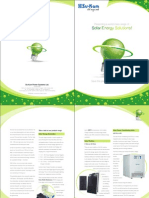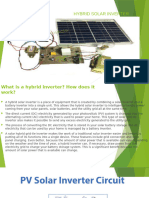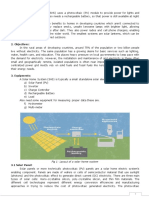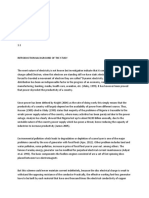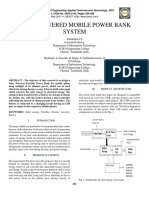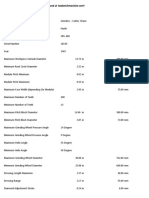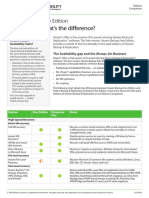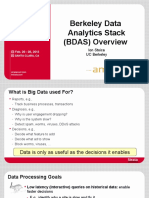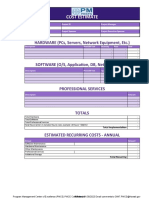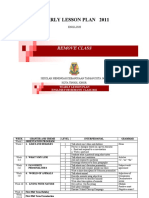Solar Computing
Solar Computing
Uploaded by
bhageshlCopyright:
Available Formats
Solar Computing
Solar Computing
Uploaded by
bhageshlOriginal Description:
Copyright
Available Formats
Share this document
Did you find this document useful?
Is this content inappropriate?
Copyright:
Available Formats
Solar Computing
Solar Computing
Uploaded by
bhageshlCopyright:
Available Formats
Solar Computing
What is Solar Computing?
The need today is to run computers in every corner of the country. Government, BFSI,
Education and FMCG, all sectors depend on ICT for effective execution. However, the
power situation in India does not permit the use of computers in large parts of rural
India.
SPV based solar power generation has emerged as a reliable and efficient power
source for those locations that are not connected to the electricity grid. Thinvent's
solar computing solution is designed specifically to allow computers to be run from
SPV based solar power.
In this document, we will study some of the facets of a solar computing system. We
will also see how such a system is different from an ordinary PC connected to a solar
power generator. Briefly, a solar computing solution should:
• Run from the direct current generated by SPV and battery, not alternating current.
• Be highly energy efficient and low power, since solar power is still quite expensive.
• Be lightweight, rugged and reliable, to reduce transport and service costs.
• Be able to operate in a hot and dusty environments.
Alternating Current versus Direct Current
Electricity is supplied using Alternating Current. AC allows efficient transmis-
sion of large amounts of power. Electrical appliances such as fans and
washing machines efficiently consume alternating current in their motors.
Electronics consume and produce Direct Current. Electronic equipment such
as LCD TVs and PCs, contain an SMPS that converts AC power to DC power.
The utility (grid) power is plugged into the AC input of the SMPS, and the
electronic components of the equipment are connected to the DC outputs.
Mobile phones, laptops or set top boxes are supplied with external chargers
or adapters. These adapters convert the AC supply to the DC voltage
required by the equipment they power.
Illustration 1: Working of a solar power
system
Electricity is predominantly produced in the world using rotating equipment –
electric generators. These generators can natively generate AC power. Solar
photo voltaic panels are electronic, and hence generate DC power. Solar power is only
generated when the sun is shining. Therefore, off-grid solar generation units are con-
nected to a storage battery. Lead acid storage batteries also store and release power
in DC form.
Solar generation systems can also supply alternating current, thus powering normal
electrical equipment. The conversion from DC to AC power is done by an inverter. The
inverter used with solar systems is the same as that employed in home power-backup
inverters – it converts the 12V or 24V DC power of the storage batteries into the 230V
AC power required by electrical equipment.
© Thinvent Technologies Pvt. Ltd. 2010-11
The usual approach to running computers from solar power, is to connect Cause of Computer Failure
together a solar generator, an inverter, and a computer that consumes AC
power. This approach unnecessarily inverts the DC power of the solar panel
into AC power, which is then rectified inside the PC's SMPS to generate the
DC power needed by its electronics components.
Inverters and SMPS are both failure prone equipment. They employ trans-
formers and other components that fail under stress and age. For example,
failure of mobile phone chargers is a common occurrence.
The second problem with inverters and SMPS is efficiency. Solar inverter effi-
SMPS Heat and Hard
ciency ranges from 90% to 95%. SMPS efficiency is south of 80%. That's a Fan Drive
Case Electroni
net efficiency of only 70%. 30% of the solar power generated is lost in inver- cs
sion and rectification!
To eliminate this unnecessary failure and wastage, Thinvent's computers
Power Consumption
run directly from the DC power supplied by solar generators. Thinvent's DC-
UPS equipment is capable of charging storage batteries using DC power Thinvent Uno 19V
from solar panels and AC power from the grid. The power from storage bat-
teries is supplied in DC form to Thinvent's solar computers. Thinvent Uno 15P
The Cost of Solar Power
Dell Inspiron One 19
The MNRE benchmarks a capital expenditure of `16 crores per MW of solar
energy generation. This translates to `160 per peak-Watt. For stand-alone Dell Inspiron 560s
solar generators, the cap-ex is more than `180 per peak-Watt. A solar panel
0 50 100 150 200
generates peak power for only four-five hours a day, thus giving us around 2
Watts
KWhr of power per year per peak-Watt. This translates to a cap-ex of `90 per
unit of electricity per year. That's a lot of investment!
Cost of power generation in India
Even at this high cost, there is no alternative to solar power. Large parts of
India are still not connected to the electricity grid, and solar is the only Solar
option available. What's more, these are the same underdeveloped areas of
the country that can benefit the most from the e-governance and education Wind
projects that solar computing projects enable.
Gas based
While solar power may not have alternatives, the onus is on us to utilise it
efficiently. Every watt of power consumption reduced from our computer,
Coal based
saves more than `200 in capital expenditure. Thinvent, through its signifi-
cant R&D investments, has scaled down computer power consumption by a 0 2 4 6 8 10 12 14 16
whopping 85%. While a PC consumes 120 to 150W of power, Thinvent's Rupees per KWh
solar computers consume only 10 to 20W of power!
The Cost of Transport and Servicing
By reducing the solar generator and computer size, Thinvent has also
reduced the cost of transportation. Most rural locations are remote and diffi-
cult to approach. The cost of transportation along bad or non-existent roads
is quite high.
Once installed, the equipment needs to be serviced. Transport costs, and
the technician time lost in travelling, are large parts of the total cost of ser-
vice. In an urban setting, servicing is done locally. The maximum travel dis- Illustration 2: Rural transport in
India is erratic and slow, leading
to a huge wastage of manpower
© Thinvent Technologies Pvt. Ltd. 2010-11 time in travel to remote sites.
Weight tance is 10 to 50 kilometres, depending on the size of the city. In a rural
setting, trained solar or computer repair technicians may be hundreds of
Thinvent Uno 19V
kilometres from the site. Rural servicing therefore has very high cost of man-
power time and transport. The solution is to procure reliable equipment that
Thinvent Uno 15P
requires less servicing. Every Rupee spent on reliability, comes back many
times in the form of long life and less failure of the equipment.
Dell Inspiron One 19
Heat and Dust – The Silent Killer
Dell Inspiron 560s
Heat is the single biggest cause of equipment failure in a tropical country
like India. Electronics convert the electricity they consume into heat. This
0 2 4 6 8 10 12
kg heat causes their temperature to rise. To keep the electronics cool, manu-
facturers use fans to cool the interiors of a computer.
Heat Dissipation Fans have a strong relationship with the dust, the other big killer of comput-
ers. As the fans circulate air, the dust in the environment enters the com-
Thinvent Uno 19V
puter, depositing on its electronics and fans. This dust slowly chokes the
fans. Most users don't even notice this slow death of the fan. Computers
Thinvent Uno 15P
also do not report the failure of a fan. Soon after the failure of the fan, the
components it was protecting will fail. The result – expense in servicing, and
Dell Inspiron One 19
in component replacement.
Dell Inspiron 560s The second problem with fans is that they consume energy themselves.
Thus, to expend the heat energy generated by the electronics, we are con-
0 100 200 300 400 500 600 700 suming further more energy. Thinvent builds its computers using cooler run-
BTU/hour ning components, which not only consume less energy, but also do not need
energy-consuming fans to run. Thinvent also uses components that are
Maximum Operating Temperature
rated to run at higher temperatures, thus eliminating the need for fans.
Thinvent Uno 19V
The final problem with fans is that they are moving parts. Any moving part
has a limited life, and needs periodic replacement.
Thinvent Uno 15P
In a rural area, it is more difficult to control ambient dust in the computer
Dell Inspiron One 19
room as compared to urban areas. Rural environmental temperatures are
also higher than urban, in the absence of powered cooling devices such as
Dell Inspiron 560s
ceiling fans and air-conditioners. Thinvent's solar computers completely
avoid the use of cooling fans, elongating their life and minimising failures. At
0 5 10 15 20 25 30 35 40 45 50 the same time, Thinvent's computers run at higher ambient temperatures as
degree Celsius compared to PCs.
One way to observe the mechanical stability and life of a product is to
Noise observe the noise it makes. The more the noise, the more moving parts
there are in the computer. These moving parts will lead to wear-and-tear and
Thinvent Uno 19V
eventual failure. Also, the noise and vibration of these moving parts will take
its toll on the life of the solid-state electronics components. We are happy to
Thinvent Uno 15P
state that Thinvent manufacturers the quietest computers in the world.
Dell Inspiron One 19
Dell Inspiron 560s
0 10 20 30 40 50 60
decibels
© Thinvent Technologies Pvt. Ltd. 2010-11
Case Studies Cost of Solar Power
Let us now look at some case studies, which will help us highlight the cost and opera- We illustrate the cost
tional advantages of using Thinvent's solar computing solution. involved in running a 1W
load for eight hours a day
Case Study – Rural School
on solar power.
Let us take the typical scenario of running 10 computers in a rural school, for 6 hours
Item Cost
a day. First we look at PC based costing:
Solar panel (2Wp) `260
Item Rate Qty Cost
Solar charger `10
PC `20,000 10 `2,00,000
Battery (1Ah) `100
Networking `5,000 1 `5,000
Inverter `10
Solar panel `25,000 10 `2,50,000
Installation, `38
Battery `15,000 5 `75,000
shipping @ 10%
UPS, CCU `50,000 1 `50,000
Total Cost `418
Total `5,80,000
Table 1: Costing of PC based computer solution for rural school
Compare this with the costing below of our solution.
Item Rate Qty Cost
Thinvent's entire
Uno 15P `12,000 9 `1,08,000 solar computing
package comes for
Networking `5,000 1 `5,000
less than the cost of
Server `40,000 1 `40,000 just a PC
Solar panel `9,500 4 `38,000
Battery `15,000 1 `15,000
DC-UPS `20,000 1 `20,000
Total `2,26,000
Table 2: Costing of Thinvent's solar computing solution for rural schools
Over 10 computers, the cost is working out to just `22,500 per unit, which is equal to
the cost of a PC + ordinary UPS. Therefore, in our solution, the solar power comes
free!
© Thinvent Technologies Pvt. Ltd. 2010-11
PC System Case Study – Telecentre
Cost Distribution
Telecentres provide rural populace with access to the ICT and eGovernance. Given
below is the cost estimate for such a centre, operating 10 hours a day, 7 days a
week.
Item Rate Qty Cost
PC `20,000 1 `20,000
Laser MFP `10,000 1 `10,000
UPS `5,000 1 `5,000
PC Networ Solar
k Panel
Battery UPS, Generator (1.5 KVA) `15,000 1 `15,000
CCU
Total `50,000
Table 3: Costing of PC based computer solution for a telecentre
The above equipment requires diesel generated power and grid supplied power. The
kiosk owner will generate diesel power for 6-8 hours a day, at a cost of `12 per unit.
The remaining time, he will operate on `7 per unit grid power (commercial rate). This
works out to `4,600 per year. Apart from this, he needs to pay up to `1 per day power
generation duty. And this does not even include the cost of operating the laser printer
and scanner.
Thinvent's solar
solution saves Let us compare this with the capital expenditure of procuring a purely solar powered
`1,000 per month in solution from Thinvent:
the running cost of a Item Rate Qty Cost
telecentre, while
enabling reliable, M5 `20,000 1 `20,000
10hour a day Inkjet MFP `5,000 1 `5,000
operation
Solar panel (100Wp total) `12,500 1 `12,500
Battery (50Ah total, say 80Ah) `9,000 1 `9,000
DC-UPS `5,000 1 `5,000
Total `51,500
Table 4: Costing of Thinvent's solar computing solution for a telecentre
While the procurement cost of both solutions are identical, there is a saving of `4,600
per year in running cost, and `3,000 per year in maintenance cost. The hassle of
securing commercial electricity connections in rural areas is also eliminated. One can
practically set up shop in any location in ten minutes, with Thinvent's solar computing
system.
© Thinvent Technologies Pvt. Ltd. 2010-11
Case Study – Rural Retail
We will now look at a major emerging market – that of rural organised retail. Assume
that we need to run one office PC cum database server, and three point-of-transaction
terminals. The system needs to operator for 8 hours a day.
Let us first look at PC based costing.
Item Rate Qty Cost
PC `20,000 4 `80,000
Networking `2,000 1 `2,000
Solar panel (240Wp per PC) `30,000 4 `1,20,000
Battery (120Ah per PC) `12,000 4 `48,000
UPS, CCU `25,000 1 `25,000
Total `2,75,000
Table 5: Costing of PC based computer solution for a rural retain centre
In comparison, Thinvent's solution provides more rugged, purpose-built transaction ter-
minals, at a much lower overall cost.
Item Rate Qty Cost
M5 `20,000 1 `20,000 Thinvent's entire
solar computing
Uno 19V `18,000 3 `54,000
package costs less
Networking `2,000 1 `2,000 than the expense on
solar powering
Solar panel (225Wp total) `10,000 3 `30,000
existing PCs
Battery (120Ah total) `12,000 1 `12,000
DC-UPS `10,000 1 `10,000
Total `1,28,000
Table 6: Costing of Thinvent's solar computing solution for a rural retail centre
It costs at least `1,75,000 to provide solar power for an existing set of four PCs. In
less than that amount, we can provide a complete new set-up that is solar powered
and comprises of rugged, no-moving-parts, purpose-built transaction terminals.
Conclusion
We hope that through this document, we have been able to convey the cost and relia -
bility advantages of using solar computers for rural ICT projects.
For more information, please feel free to contact us on the addresses given below.
We'll be happy to design a solution as per your needs.
Thinvent Technologies Pvt. Ltd.
www.thinvent.in
S-90 · Uppal South End · Sohna Road · Gurgaon
+91 124 425 2359 · info@thinvent.in
© Thinvent Technologies Pvt. Ltd. 2010-11
You might also like
- Manual Ottimo EngDocument113 pagesManual Ottimo EngAchimMariusVasile100% (1)
- DESIGN AND IMPLEMENTATION OF 1.5kVA PURE SINEWAVE INVERTERDocument49 pagesDESIGN AND IMPLEMENTATION OF 1.5kVA PURE SINEWAVE INVERTERemmanuel akoji100% (1)
- Automated Switching Solar Power Grid Tie Inverter Using Embedded SystemDocument5 pagesAutomated Switching Solar Power Grid Tie Inverter Using Embedded SystemBONFRINGNo ratings yet
- Indian National Solar MissionDocument114 pagesIndian National Solar MissionH Janardan PrabhuNo ratings yet
- Tt98 122414 B TT 3000e Installation ManualDocument97 pagesTt98 122414 B TT 3000e Installation ManualPaul O'Shea100% (1)
- Lift Station Preliminary Checklist 201203Document11 pagesLift Station Preliminary Checklist 201203ZoebairNo ratings yet
- The Sunday Times - Die Die Must Diablo - Fans Reacting To The Launch of Diablo 3Document1 pageThe Sunday Times - Die Die Must Diablo - Fans Reacting To The Launch of Diablo 3Kenneth Goh SZNo ratings yet
- Solar Based Home Automation SystemDocument7 pagesSolar Based Home Automation SystemHamza MunibNo ratings yet
- Smart DC Micro-Grid For Effective Utilization of Solar EnergyDocument9 pagesSmart DC Micro-Grid For Effective Utilization of Solar EnergyAlapati Nageswara RaoNo ratings yet
- Chapter One Smps InverterDocument10 pagesChapter One Smps Inverterolawale gbadeboNo ratings yet
- Researchpaper Smart DC Microgrid For Effective Utilization of Solar EnergyDocument5 pagesResearchpaper Smart DC Microgrid For Effective Utilization of Solar EnergyLava KumarNo ratings yet
- Design and Implementation of Solar Based DC Grid Using Arduino UnoDocument5 pagesDesign and Implementation of Solar Based DC Grid Using Arduino UnoMobeenNo ratings yet
- IJCRT2207257Document5 pagesIJCRT2207257ayushrajaryan69No ratings yet
- Emma ProjectDocument48 pagesEmma ProjectChristianNo ratings yet
- Solar InverterDocument49 pagesSolar InverterBrahmpal Bhardwaj100% (2)
- Efficient Use of Solar Power Energy: Ruby Vij, Research Scholar D.A.V Institute of Tech. JalandharDocument3 pagesEfficient Use of Solar Power Energy: Ruby Vij, Research Scholar D.A.V Institute of Tech. JalandharPramod KumarNo ratings yet
- InverterDocument23 pagesInverterBittu Kumar Sinha100% (1)
- Solar Inverter SystemDocument32 pagesSolar Inverter Systemabel tibebuNo ratings yet
- Parts of Solar System:: 1. What Is A Solar Cable?Document6 pagesParts of Solar System:: 1. What Is A Solar Cable?muhammad umairNo ratings yet
- Final Report Vaibhav Solar Power Inverter NewDocument39 pagesFinal Report Vaibhav Solar Power Inverter NewVaibhav Vasu1397No ratings yet
- EPRI DCpower June2006Document30 pagesEPRI DCpower June2006ankurmalviyaNo ratings yet
- Calculation of Electrical Energy With SolarDocument4 pagesCalculation of Electrical Energy With Solarmohamed parvez100% (1)
- Wireless Electricity: Sidharth .S Ece S3 Roll No.65Document20 pagesWireless Electricity: Sidharth .S Ece S3 Roll No.65SidhanNo ratings yet
- Combine PDFDocument98 pagesCombine PDFSuranjan KarNo ratings yet
- Energy ManagementDocument55 pagesEnergy ManagementNjitnumNo ratings yet
- Solar Energy Solutions! Solar Energy Solutions!: Presenting A World-Class Range ofDocument4 pagesSolar Energy Solutions! Solar Energy Solutions!: Presenting A World-Class Range ofmahaumaNo ratings yet
- Chapter:-1: 1.1 Introduction To Solar EnergyDocument15 pagesChapter:-1: 1.1 Introduction To Solar EnergySwaroopNo ratings yet
- CH 5Document35 pagesCH 5AbrhaNo ratings yet
- Estimation of Loads For Off-Grid Solar Photovoltaic SystemsDocument8 pagesEstimation of Loads For Off-Grid Solar Photovoltaic SystemsInternational Journal of Power Electronics and Drive SystemsNo ratings yet
- Solar Rooftop Power Generation System by Using IOT (Arduino & Blynk)Document4 pagesSolar Rooftop Power Generation System by Using IOT (Arduino & Blynk)International Journal of Innovative Science and Research TechnologyNo ratings yet
- Dual Axis Solar Panel ComponentsDocument11 pagesDual Axis Solar Panel ComponentsRaj Kothari MNo ratings yet
- Solar Panel PDFDocument3 pagesSolar Panel PDFArnab DeyNo ratings yet
- HYBRID SOLAR INVERTER (Autosaved)Document6 pagesHYBRID SOLAR INVERTER (Autosaved)agubachinedu120No ratings yet
- Solar Home System - BasicDocument6 pagesSolar Home System - BasicShamim MollaNo ratings yet
- Block Diagram of A Photo Voltaic SystemDocument3 pagesBlock Diagram of A Photo Voltaic Systemkeshav246100% (1)
- Voltage Regulation By: Grid Using PV PlantDocument19 pagesVoltage Regulation By: Grid Using PV PlantUdgam TiwariNo ratings yet
- Pamas EnergyDocument24 pagesPamas Energyakshay7573No ratings yet
- Hybrid Solar Inverter: Project Guide MR - Vishwaprakash BabuDocument12 pagesHybrid Solar Inverter: Project Guide MR - Vishwaprakash BabuKalyan Reddy AnuguNo ratings yet
- CONSTRUCTION of Solar InvertersDocument6 pagesCONSTRUCTION of Solar InvertersJunaid Mirza's CreationNo ratings yet
- Design and Implementation of 5kVA PhotovDocument92 pagesDesign and Implementation of 5kVA PhotovMarc DonaldNo ratings yet
- Pratikruti-2 17: Grid Connected Solar Rooftop SystemDocument1 pagePratikruti-2 17: Grid Connected Solar Rooftop Systems3ct0r 10No ratings yet
- What Is A Solar PanelDocument3 pagesWhat Is A Solar Panelyashwanthkanakam03No ratings yet
- Adra Muler SolarDocument36 pagesAdra Muler SolarghershensoftNo ratings yet
- P.HD Research ProposalDocument5 pagesP.HD Research Proposaldheerajkumar02527289No ratings yet
- Design and Development of A Grid Tied Solar InverterDocument5 pagesDesign and Development of A Grid Tied Solar InverterSyed ZadaaNo ratings yet
- Residential Guide To Solar PowerDocument35 pagesResidential Guide To Solar PowerrenewenergymanNo ratings yet
- The Solar Inverter For Grid Connected PV SystemsDocument12 pagesThe Solar Inverter For Grid Connected PV Systemssalem BEN MOUSSANo ratings yet
- In VeterDocument6 pagesIn VeterIbrahim khoshnawNo ratings yet
- Bridge Rectifier 1916022Document6 pagesBridge Rectifier 1916022RishavNo ratings yet
- Constant Electricity Generation From Self-Charging InverterDocument5 pagesConstant Electricity Generation From Self-Charging InverterMichael Adeiza EmmanuelNo ratings yet
- Solar Photovoltaic Power For IndiaDocument74 pagesSolar Photovoltaic Power For IndiaH Janardan PrabhuNo ratings yet
- Hybrid Power Generation SlideDocument23 pagesHybrid Power Generation SlideCnp1 Cnp1No ratings yet
- Solar Inverter and Tracking SystemDocument20 pagesSolar Inverter and Tracking SystemGANDE SAI KIRANNo ratings yet
- A Study of Solar Power Monitoring System Using Internet of Things (IOT)Document4 pagesA Study of Solar Power Monitoring System Using Internet of Things (IOT)International Journal of Innovative Science and Research TechnologyNo ratings yet
- Chapter Three DesignDocument20 pagesChapter Three DesignADEFRIS BELACHEWNo ratings yet
- Major ProjectDocument4 pagesMajor ProjectSaroj kumar BiswasNo ratings yet
- ProDocument13 pagesProTomiwa KutiNo ratings yet
- Solar Power Plant SystemDocument12 pagesSolar Power Plant SystemAhsan NazeerNo ratings yet
- Working Principle of Solar PVDocument5 pagesWorking Principle of Solar PVkarthikgoldenrock100% (4)
- Solar Cell System Design-2Document12 pagesSolar Cell System Design-2spotifyladderNo ratings yet
- Solar System CompleteDocument16 pagesSolar System CompleteAlok JainNo ratings yet
- Solar Powered Mobile Power Bank SystemDocument4 pagesSolar Powered Mobile Power Bank SystemRidhwan FirdausNo ratings yet
- Fill Up Form For IEC ApplicationDocument1 pageFill Up Form For IEC ApplicationbhageshlNo ratings yet
- Hurth srs400 18136 1967Document2 pagesHurth srs400 18136 1967bhageshlNo ratings yet
- Using The Supplemental PFM Outputs On The PMAC2 J7 (Handwheel) ConnectorDocument1 pageUsing The Supplemental PFM Outputs On The PMAC2 J7 (Handwheel) ConnectorbhageshlNo ratings yet
- Duplicate Cleaner logDocument4 pagesDuplicate Cleaner logbhageshlNo ratings yet
- Additional Stepper and Servo AxesDocument1 pageAdditional Stepper and Servo AxesbhageshlNo ratings yet
- Virtual Axis Monitoring MotionDocument4 pagesVirtual Axis Monitoring MotionbhageshlNo ratings yet
- Conditions Influencing PerformancesDocument3 pagesConditions Influencing PerformancesbhageshlNo ratings yet
- 2 Channel Freq. GeneratorDocument3 pages2 Channel Freq. GeneratorbhageshlNo ratings yet
- Blackbox Technologies: Presents Introduction To Gear Inspection Software (Gearsoft)Document25 pagesBlackbox Technologies: Presents Introduction To Gear Inspection Software (Gearsoft)bhageshlNo ratings yet
- Serial & Modbus Example ExampleDocument7 pagesSerial & Modbus Example ExamplebhageshlNo ratings yet
- Direct Drive Motor Mounting FlangeDocument1 pageDirect Drive Motor Mounting FlangebhageshlNo ratings yet
- Optibelt BlackBox GaneshMillDocument2 pagesOptibelt BlackBox GaneshMillbhageshlNo ratings yet
- Optimization of Grinding OperationDocument3 pagesOptimization of Grinding OperationbhageshlNo ratings yet
- Lead Screw Phi 18Document1 pageLead Screw Phi 18bhageshlNo ratings yet
- Design and Validation of XY Flexure Mechanism: Pratik M. Waghmare, Shrishail B. SollapurDocument5 pagesDesign and Validation of XY Flexure Mechanism: Pratik M. Waghmare, Shrishail B. SollapurbhageshlNo ratings yet
- Design and Validation of XY Flexure Mechanism: Pratik M. Waghmare, Shrishail B. SollapurDocument5 pagesDesign and Validation of XY Flexure Mechanism: Pratik M. Waghmare, Shrishail B. SollapurbhageshlNo ratings yet
- Veeam Backup 9 5 Free Vs Paid Comparison DsDocument6 pagesVeeam Backup 9 5 Free Vs Paid Comparison DsSteven HallNo ratings yet
- Datasheet l9110Document2 pagesDatasheet l9110frajaprNo ratings yet
- C-20 - CCL Experiment No 2B - Virtual BoxDocument11 pagesC-20 - CCL Experiment No 2B - Virtual Boxriddhijavkar30No ratings yet
- Best Practice Using DB2 Compression Feature in SAP EnvironmentDocument30 pagesBest Practice Using DB2 Compression Feature in SAP EnvironmentsinghashwiniNo ratings yet
- Berkeley Data Analytics Stack (BDAS) Overview: Ion Stoica UC BerkeleyDocument28 pagesBerkeley Data Analytics Stack (BDAS) Overview: Ion Stoica UC BerkeleysurenNo ratings yet
- Assembly Language For Intel-Based Computers, 4 EditionDocument29 pagesAssembly Language For Intel-Based Computers, 4 Editiongangster99100% (1)
- PIC16F87XA Rev. B7 Silicon/Data Sheet ErrataDocument6 pagesPIC16F87XA Rev. B7 Silicon/Data Sheet ErrataSilviu CeausuNo ratings yet
- Matka KalyanDocument10 pagesMatka KalyanAshvinNo ratings yet
- Ritesh AhyaDocument2 pagesRitesh Ahyagabbu_No ratings yet
- AutoCAD Questions and AnswersDocument13 pagesAutoCAD Questions and AnswersGoutham Nanda100% (3)
- Asynchronous Programming in C#Document8 pagesAsynchronous Programming in C#WebDeveloper777No ratings yet
- P-9 Cost Estimating WorksheetDocument3 pagesP-9 Cost Estimating WorksheetλλNo ratings yet
- RPT English Peralihan 2021Document4 pagesRPT English Peralihan 2021TAY FARIDAH67% (3)
- PC Operations, Maintenance and NetworkingDocument15 pagesPC Operations, Maintenance and NetworkingJun MagduaNo ratings yet
- Jaunt VR Field GuideDocument68 pagesJaunt VR Field GuideRobertoJmzNo ratings yet
- Mscit 302Document2 pagesMscit 302api-3782519100% (2)
- Manual de Usuario Tarjeta Madre GigaByte GA-990FXA-UD3 v.3.0Document104 pagesManual de Usuario Tarjeta Madre GigaByte GA-990FXA-UD3 v.3.0Sexto SemestreNo ratings yet
- Posiflex JPOS Installation Guide - Win PDFDocument11 pagesPosiflex JPOS Installation Guide - Win PDFpundaiNo ratings yet
- 7 Type AbnormalitiesDocument24 pages7 Type AbnormalitiesShantanu Shukla100% (2)
- HP 2009m 2009f LCD Monitor Service ManualDocument72 pagesHP 2009m 2009f LCD Monitor Service ManualFrengky Rm0% (1)
- Cisco Introduction To Cyber Security Chap-4Document9 pagesCisco Introduction To Cyber Security Chap-4MukeshNo ratings yet
- Exception HandlingDocument34 pagesException HandlingSheeba DhuruvarajNo ratings yet
- Operating Manual For ASHIDA Numerical Inverse Time Under Voltage Relay Type: Adr 112ADocument27 pagesOperating Manual For ASHIDA Numerical Inverse Time Under Voltage Relay Type: Adr 112A1981todurkarNo ratings yet
- VX Search Rule-Based File SearchDocument68 pagesVX Search Rule-Based File SearchFlexenseNo ratings yet
- Computers and Quantity Surveyors (PDFDrive) PDFDocument217 pagesComputers and Quantity Surveyors (PDFDrive) PDFsitrakiniavoNo ratings yet
- Raport Calculator Birou 06.09.2012Document523 pagesRaport Calculator Birou 06.09.2012Udroiu DumitruNo ratings yet

























